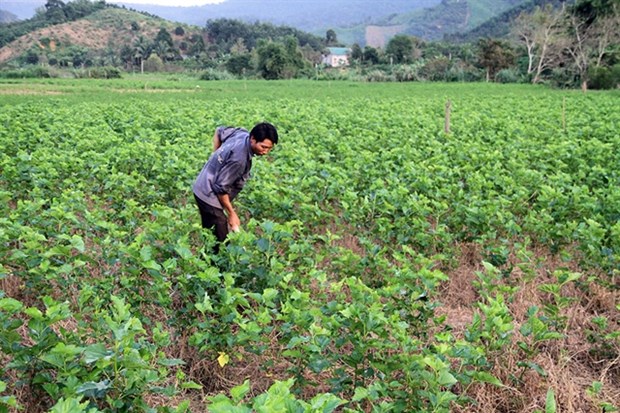Lam Dong province unveils 5-year plan to develop sericulture
The People’s Committee of Lam Dong province has approved a five-year plan for the sericulture industry which targets having 9,500-10,000ha of mulberry farms by 2023.
 Planting mulberry in Lam Dong province’s Da Teh district (Photo: baolamdong.vn)
Planting mulberry in Lam Dong province’s Da Teh district (Photo: baolamdong.vn)Lam
Dong (VNA) - The People’s Committee of Lam Dong province has
approved a five-year plan for the sericulture industry which targets having
9,500-10,000ha of mulberry farms by 2023.
Of them 8,100-8,500ha will have new and hybrid mulberry varieties with high yields and 1,900-2,000ha will be farmed using advanced techniques.
The Tay Nguyen (Central Highlands) province will produce at least 30 percent of its demand for silkworm eggs, 14,000-14,500 tonnes of silkworm cocoons a year and 1,800-1,900 tonnes of silk a year.
The plan envisages, to create value chains, establishing at least three linkages between districts: Duc Trong-Lam Ha-Dam Rong; Di Linh-Bao Lam-Bao Loc and Da Huoai-Da Teh-Cat Tien.
The province will take several measures to sustainably develop sericulture, including strengthening research and production of silkworm eggs and giving priority to switching to certified high-yield mulberry varieties like S7-CB, TBL-03, VA-201 and TBL-05.
It also plans to expand the area under mulberry in places that have silk producing plants and develop sericulture villages that also offer tourism services.
It will solicit investment in mulberry farms and silkworm breeding and support activities to promote the province’s silk in Vietnam and abroad.
It will help farmers switch to mulberry from low-yield rice farming in places like Dam Rong, Da Huoai, Da Teh, and Cat Tien districts and from perennial industrial trees in Duc Trong, Lam Ha, Di Linh, and Bao Lam districts and Bao Loc city.
Bao Loc, Lam Ha and Di Linh are the province’s leading silk producers.
The province produced 8,904 tonnes of silkworm cocoons and 1,187 tonnes of silks last year. It accounts for 67 percent of the country’s total mulberry area.
More than 14,000 households are involved in growing mulberry and breeding silkworms.
The sericulture industry boomed in the 1990s but later declined because of failure to adopt advanced silk production techniques. There has been a revival since 2010.
The industry now plays an important role in the province’s socio-economic development and agriculture, according to its People’s Committee.-VNA
Of them 8,100-8,500ha will have new and hybrid mulberry varieties with high yields and 1,900-2,000ha will be farmed using advanced techniques.
The Tay Nguyen (Central Highlands) province will produce at least 30 percent of its demand for silkworm eggs, 14,000-14,500 tonnes of silkworm cocoons a year and 1,800-1,900 tonnes of silk a year.
The plan envisages, to create value chains, establishing at least three linkages between districts: Duc Trong-Lam Ha-Dam Rong; Di Linh-Bao Lam-Bao Loc and Da Huoai-Da Teh-Cat Tien.
The province will take several measures to sustainably develop sericulture, including strengthening research and production of silkworm eggs and giving priority to switching to certified high-yield mulberry varieties like S7-CB, TBL-03, VA-201 and TBL-05.
It also plans to expand the area under mulberry in places that have silk producing plants and develop sericulture villages that also offer tourism services.
It will solicit investment in mulberry farms and silkworm breeding and support activities to promote the province’s silk in Vietnam and abroad.
It will help farmers switch to mulberry from low-yield rice farming in places like Dam Rong, Da Huoai, Da Teh, and Cat Tien districts and from perennial industrial trees in Duc Trong, Lam Ha, Di Linh, and Bao Lam districts and Bao Loc city.
Bao Loc, Lam Ha and Di Linh are the province’s leading silk producers.
The province produced 8,904 tonnes of silkworm cocoons and 1,187 tonnes of silks last year. It accounts for 67 percent of the country’s total mulberry area.
More than 14,000 households are involved in growing mulberry and breeding silkworms.
The sericulture industry boomed in the 1990s but later declined because of failure to adopt advanced silk production techniques. There has been a revival since 2010.
The industry now plays an important role in the province’s socio-economic development and agriculture, according to its People’s Committee.-VNA













